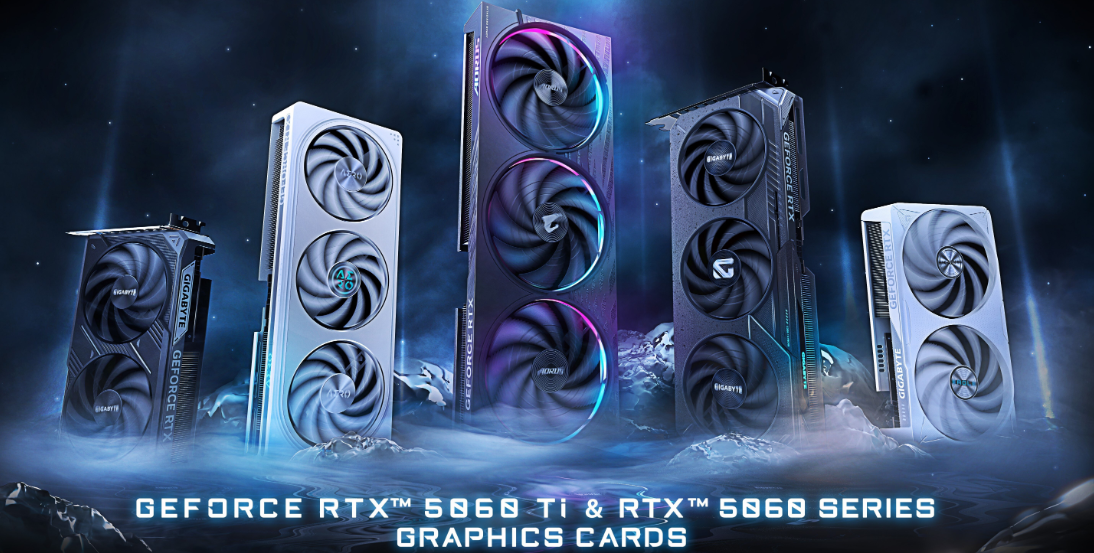NVIDIA Launches GeForce RTX 50 Series: A Game-Changer for Graphics Technology
Get ready to experience the future of graphics with NVIDIA's GeForce RTX 50 Series. Powered by the revolutionary Blackwell architecture, these GPUs promise unmatched performance, stunning visuals, and AI-driven innovation. The RTX 50 Series is a game-changer for gamers & creators alike.

The world of graphics technology is evolving at an unprecedented pace, and NVIDIA continues to lead the charge with its latest innovation—the GeForce RTX 50 series. Unveiled as the next generation of consumer GPUs, the RTX 50 series promises to redefine gaming, content creation, and AI-driven applications with groundbreaking performance and cutting-edge features. Built on the Blackwell architecture, this series is set to deliver unparalleled power, efficiency, and realism, solidifying NVIDIA's dominance in the GPU market. In this comprehensive blog article, we’ll dive deep into the details of the RTX 50 series, explore its key features, discuss its impact on various industries, and analyze what it means for gamers, creators, and tech enthusiasts alike.
The Blackwell Architecture: Powering the Future
At the heart of the GeForce RTX 50 series lies NVIDIA’s Blackwell architecture, a revolutionary leap forward in GPU design. Named after David Blackwell, a renowned mathematician and statistician, this architecture is engineered to push the boundaries of performance and efficiency. Unlike its predecessors, the Blackwell architecture is tailored to handle the most demanding workloads, from ultra-realistic gaming to complex AI computations.
One of the standout aspects of Blackwell is its focus on energy efficiency. With rising concerns over power consumption in high-performance computing, NVIDIA has optimized the architecture to deliver more performance per watt. This means gamers and professionals can enjoy top-tier performance without the exorbitant energy costs or thermal challenges often associated with cutting-edge hardware. Additionally, the architecture is designed to support advanced manufacturing processes, likely utilizing TSMC’s latest nodes, which further enhances its efficiency and performance capabilities.
The Blackwell architecture also introduces significant improvements in ray tracing and AI-driven rendering. Ray tracing, a technology that simulates realistic lighting, shadows, and reflections, has been a hallmark of NVIDIA’s RTX series since its inception. With the RTX 50 series, ray tracing performance is expected to reach new heights, enabling developers to create visually stunning worlds with unprecedented detail. Meanwhile, AI-powered features like DLSS (Deep Learning Super Sampling) are set to receive major upgrades, offering even sharper visuals and smoother frame rates, even at higher resolutions.
GeForce RTX 50 Series: Models and Specifications
While NVIDIA has not yet released the full lineup of the RTX 50 series at the time of writing, early announcements and leaks suggest a tiered structure similar to previous generations. The series is expected to include flagship models like the RTX 5090 and RTX 5080, alongside more accessible options such as the RTX 5070 and RTX 5060. Each model is likely to cater to different segments of the market, from hardcore enthusiasts seeking the ultimate performance to budget-conscious gamers looking for a balance of power and affordability.
The flagship RTX 5090 is rumored to be a powerhouse, potentially featuring up to 32GB of GDDR7 memory and a massive boost in CUDA core count compared to the RTX 4090. This model is poised to dominate 8K gaming and professional workloads like 3D rendering and video editing. Meanwhile, the RTX 5080 is expected to offer a compelling middle ground, delivering near-flagship performance at a more palatable price point. Lower-tier models like the RTX 5070 and RTX 5060 will likely target 1440p and 1080p gamers, ensuring that the benefits of the Blackwell architecture are accessible to a wider audience.
One of the most exciting advancements in the RTX 50 series is the adoption of GDDR7 memory. This next-generation memory standard offers significantly higher bandwidth and lower latency compared to GDDR6X, enabling faster data transfer and improved performance in memory-intensive applications. Combined with the Blackwell architecture’s enhanced memory controller, GDDR7 is expected to eliminate bottlenecks and provide a smoother experience in games and creative software.
Ray Tracing and DLSS: Redefining Visual Fidelity
Ray tracing has become a cornerstone of modern graphics technology, and NVIDIA continues to innovate in this space with the RTX 50 series. The Blackwell architecture is rumored to include dedicated hardware for ray tracing that is even more powerful than the RT cores found in the RTX 40 series. This means faster and more accurate rendering of lighting effects, shadows, and reflections, resulting in games that look closer to real life than ever before.
However, ray tracing is notoriously demanding on hardware, often leading to significant performance drops even on high-end GPUs. This is where NVIDIA’s DLSS technology comes into play. DLSS uses AI to upscale lower-resolution images to higher resolutions, delivering near-native quality visuals with a fraction of the performance cost. The RTX 50 series is expected to feature an updated version of DLSS, potentially dubbed DLSS 4.0, which will further refine image quality and reduce artifacts. This technology will be a game-changer for gamers looking to enjoy ray-traced titles at high frame rates and resolutions without sacrificing visual fidelity.
Beyond gaming, these advancements in ray tracing and AI rendering have profound implications for industries like film and animation. Content creators can leverage the power of the RTX 50 series to render complex scenes in real time, streamlining workflows and reducing production times. Whether you’re a game developer, a 3D artist, or a filmmaker, the RTX 50 series promises to be a transformative tool for creative expression.
AI at the Core: Expanding Possibilities
NVIDIA has long been a pioneer in AI, and the RTX 50 series continues this tradition by integrating advanced AI capabilities directly into the GPU. The Blackwell architecture is designed to accelerate AI workloads, making it ideal for applications ranging from machine learning to generative AI. For gamers, this translates to smarter NPCs (non-player characters), more realistic physics simulations, and adaptive gameplay experiences that evolve based on player behavior.
One area where AI is expected to shine in the RTX 50 series is voice and video processing. With the rise of streaming and content creation, tools like NVIDIA Broadcast have become invaluable for enhancing audio and video quality. The RTX 50 series is likely to build on this foundation, offering improved noise cancellation, background blur, and even real-time voice modulation powered by AI. These features will make it easier than ever for creators to produce professional-grade content directly from their gaming rigs.
Moreover, the integration of AI extends to energy management and performance optimization. The RTX 50 series is expected to use AI algorithms to dynamically adjust power consumption and clock speeds based on workload demands. This not only improves efficiency but also extends the lifespan of the hardware by reducing unnecessary strain during lighter tasks.
Performance and Gaming: What to Expect
While concrete performance benchmarks for the RTX 50 series are not yet available, industry speculation and NVIDIA’s track record suggest that these GPUs will set new standards for gaming performance. The flagship RTX 5090, for instance, is rumored to deliver a generational leap of over 50% compared to the RTX 4090 in terms of raw performance. This would make it the go-to choice for 8K gaming, a resolution that remains out of reach for most current-gen hardware without significant compromises.
For competitive gamers, the RTX 50 series is expected to offer ultra-low latency and high refresh rate support, ensuring smooth and responsive gameplay in fast-paced titles. Combined with technologies like NVIDIA Reflex, which reduces input lag, these GPUs will provide a competitive edge in esports and multiplayer games.
Beyond raw performance, the RTX 50 series is also likely to introduce new features aimed at enhancing the gaming experience. For example, NVIDIA may expand on its GameStream technology, allowing players to seamlessly stream games to multiple devices with minimal latency. Additionally, support for emerging standards like HDMI 2.1b and DisplayPort 2.0 will ensure compatibility with the latest monitors and TVs, enabling features like Variable Refresh Rate (VRR) and Auto Low Latency Mode (ALLM).
Impact on Content Creation and Professional Workloads
The GeForce RTX 50 series isn’t just for gamers—it’s also a powerhouse for professionals in fields like video editing, 3D modeling, and AI research. The combination of high core counts, massive memory capacity, and AI acceleration makes these GPUs ideal for rendering complex projects in software like Blender, Adobe Premiere Pro, and Autodesk Maya.
For video editors, the RTX 50 series is expected to offer significant improvements in encoding and decoding performance, supporting formats like AV1 with greater efficiency. AV1, a royalty-free video codec, is gaining traction for its ability to deliver high-quality video at lower bitrates, and NVIDIA’s hardware-level support for AV1 will be a boon for streamers and content creators looking to optimize their workflows.
In the realm of AI research, the Blackwell architecture’s tensor cores are designed to accelerate machine learning tasks, making the RTX 50 series a viable option for developers and data scientists. Whether you’re training neural networks or running simulations, these GPUs promise to deliver the computational power needed to tackle even the most demanding projects.
Pricing and Availability: What We Know So Far
As with any new GPU launch, pricing and availability are hot topics for the RTX 50 series. While NVIDIA has not officially announced pricing details, industry analysts predict that the flagship RTX 5090 could carry a premium price tag, potentially exceeding $2,000, given its rumored specifications and target audience of enthusiasts and professionals. Mid-range models like the RTX 5080 and RTX 5070 are expected to be more competitively priced, likely falling in the $800–$1,200 range, while the entry-level RTX 5060 may target a sub-$500 price point to attract budget gamers.
Availability is another concern, as recent GPU launches have been plagued by supply chain issues and scalping. NVIDIA has reportedly partnered with TSMC to ramp up production of Blackwell-based GPUs, but global demand for high-end graphics cards remains strong. As such, prospective buyers may need to act quickly or face long wait times when the RTX 50 series hits the market, with a rumored release window in late 2024 or early 2025.
The Competitive Landscape: NVIDIA vs. AMD and Intel
NVIDIA’s dominance in the GPU market is undeniable, but the RTX 50 series will face competition from AMD’s RDNA 4 architecture and Intel’s Arc Battlemage GPUs. AMD has been gaining ground with its Radeon RX 7000 series, offering competitive performance at lower price points, while Intel is working to carve out a niche with its budget-friendly Arc lineup. However, NVIDIA’s focus on ray tracing, AI, and software optimization (via tools like DLSS and CUDA) gives it a significant edge in both gaming and professional applications.
The RTX 50 series is likely to widen this gap, as NVIDIA’s Blackwell architecture appears to be a step ahead in terms of raw power and efficiency. That said, pricing will play a crucial role in determining market share. If NVIDIA opts for aggressive pricing, it could further solidify its position; if not, AMD and Intel may capitalize on affordability to attract cost-conscious consumers.
Why the RTX 50 Series Matters
The launch of the GeForce RTX 50 series is more than just a hardware upgrade—it’s a glimpse into the future of graphics technology. From gaming to content creation to AI research, these GPUs have the potential to transform how we interact with digital content. For gamers, the RTX 50 series promises unparalleled visual fidelity and performance, making it possible to experience games as they were meant to be played. For creators, it offers the tools to bring ambitious projects to life with speed and precision. And for tech enthusiasts, it represents the cutting edge of what’s possible in consumer hardware.
As we await the official release of the RTX 50 series, anticipation continues to build. NVIDIA has a history of delivering on its promises, and early indications suggest that the Blackwell architecture will be no exception. Whether you’re a hardcore gamer, a professional artist, or simply someone passionate about technology, the RTX 50 series is shaping up to be a landmark release that will define the next era of graphics innovation.
Conclusion: A New Era of Graphics Awaits
The NVIDIA GeForce RTX 50 series, powered by the Blackwell architecture, is poised to set new benchmarks in performance, efficiency, and visual quality. With advancements in ray tracing, AI-driven rendering, and memory technology, these GPUs are not just incremental upgrades but transformative tools for gamers and professionals alike. While pricing and availability remain key questions, there’s no doubt that the RTX 50 series will push the boundaries of what’s possible in graphics technology.
As we move closer to the rumored release window, the excitement surrounding the RTX 50 series is palpable. Whether you’re upgrading your gaming rig, building a workstation for creative projects, or simply staying on top of the latest tech trends, NVIDIA’s latest offering is worth keeping an eye on. The future of graphics is here, and it’s brighter than ever.
References & Citations
- NVIDIA Official Website. "GeForce RTX Technology Overview." Retrieved from NVIDIA.com
- TechRadar. "Rumors and Speculations on NVIDIA RTX 50 Series Specifications." Retrieved from TechRadar.com
- Tom’s Hardware. "Blackwell Architecture: What We Know So Far." Retrieved from TomsHardware.com
- PC Gamer. "DLSS 4.0 and the Future of AI Rendering." Retrieved from PCGamer.com




